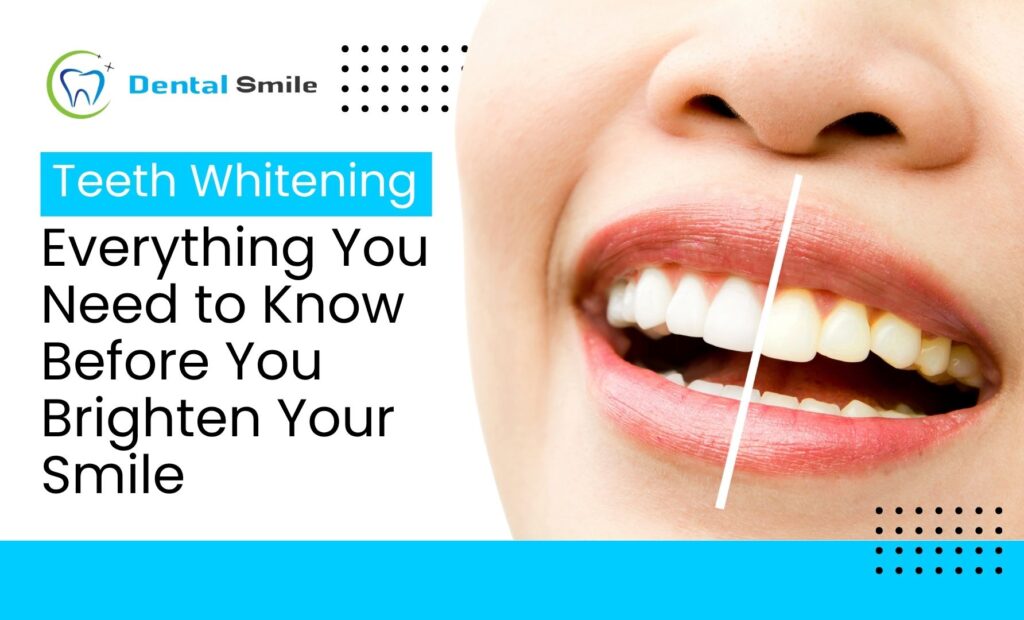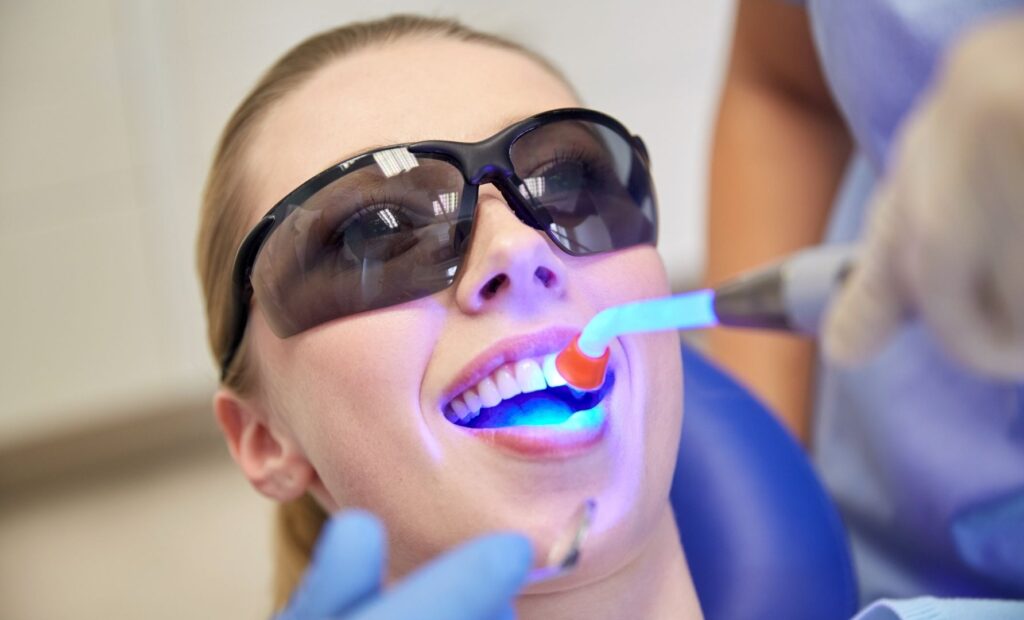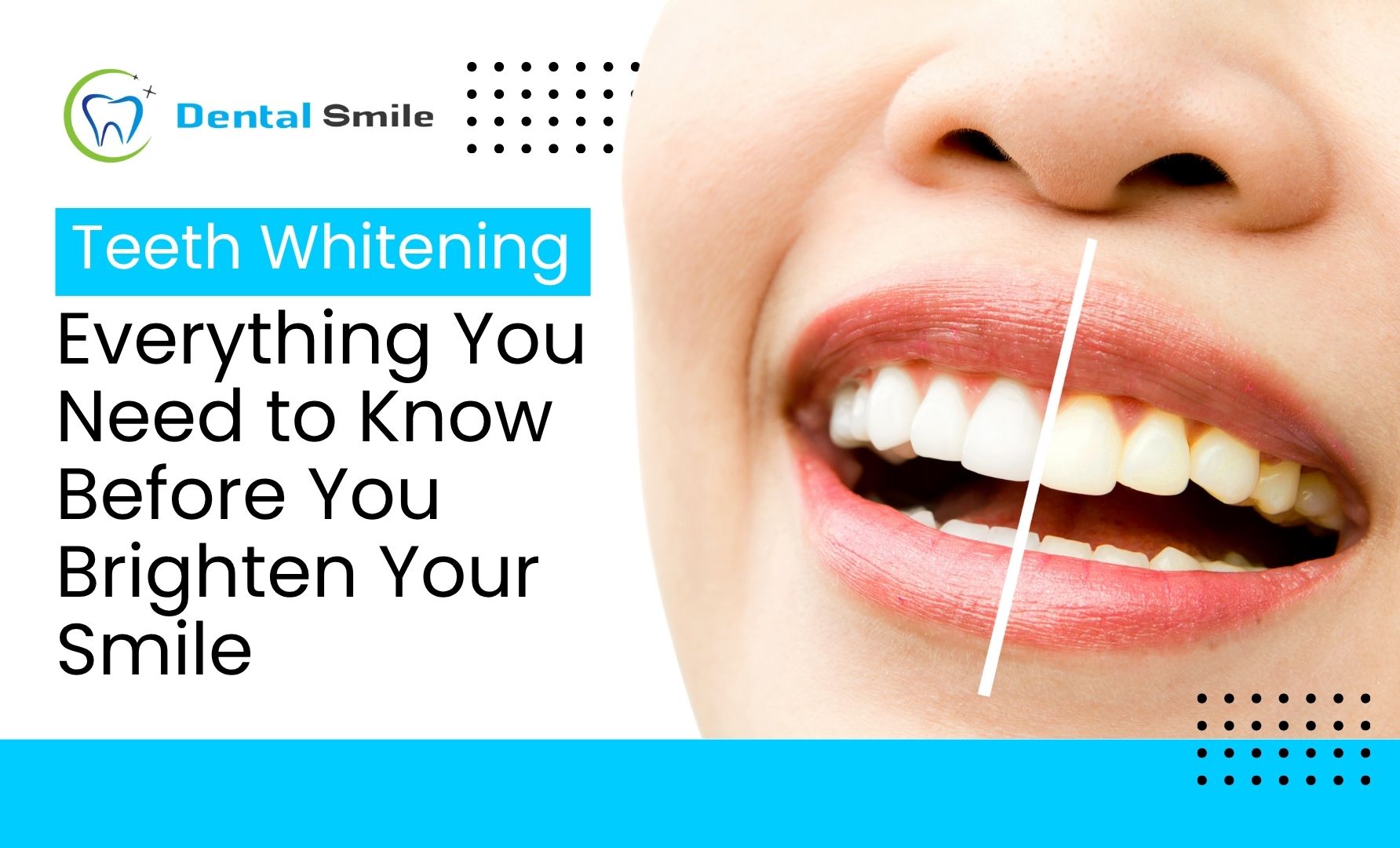A white, radiant smile can instantly boost your confidence and make a lasting impression. It’s no surprise that teeth whitening is one of the most requested cosmetic dental treatments worldwide. But before trying that new whitening kit or booking a laser session, it’s essential to understand how it works, what causes tooth discoloration, and which options are safest and most effective.

Why Do Teeth Turn Yellow or Dark?
Tooth discoloration can happen for several reasons, and understanding the cause helps choose the right whitening method.
1. Extrinsic stains (surface stains):
These are caused by lifestyle habits such as coffee, tea, red wine, tobacco, and dark-colored foods. The stains settle on the enamel the hard outer layer of your teeth.
2. Intrinsic stains (internal discoloration):
These affect the inner structure (dentin) and may result from aging, certain medications (like tetracycline), excessive fluoride, or trauma to a tooth. Intrinsic stains are harder to remove and may require professional whitening or veneers.
3. Aging and genetics:
Over time, enamel naturally wears down, revealing the yellowish dentin underneath. Genetics also plays a role in how white your teeth are to begin with.
How Teeth Whitening Works
Teeth whitening is a process that lightens the color of your teeth using chemical or physical methods.
- Bleaching agents like hydrogen peroxide or carbamide peroxide break down dark pigment molecules, making your teeth appear lighter.
- Abrasive methods (in whitening toothpastes) help scrub off surface stains but don’t change the internal tooth color.
The peroxide penetrates the enamel and reacts with discolored molecules, oxidizing them and turning yellow or brown shades into lighter tones.
Types of Teeth Whitening Treatments
There’s no “one-size-fits-all” solution. Here are the most popular whitening methods, from professional treatments to at-home options.
1. In-Office Professional Whitening
This is the fastest and most effective option. A dentist applies a high-concentration whitening gel and may use a special light or laser to accelerate the process.
Duration: 60–90 minutes
Results: Up to 5–8 shades lighter in one session
Ideal for: People with healthy teeth and gums who want instant results.
2. Dentist-Provided Custom Whitening Trays
Your dentist creates custom-fitted trays and provides whitening gel to use at home.
Duration: 1–2 hours daily for 2–3 weeks
Results: Natural and even whitening
Ideal for: Those preferring gradual, controlled whitening.
3. Over-the-Counter (OTC) Whitening Kits
Available as strips, gels, pens, or LED-light kits, these are accessible and budget-friendly.
Duration: Daily use for 10–14 days
Results: Mild to moderate improvement
Ideal for: People with minor staining and healthy enamel.
4. Whitening Toothpastes & Mouthwashes
These remove surface stains through mild abrasives or low levels of peroxide.
Results: Subtle whitening with regular use
Tip: Avoid overusing harsh abrasive toothpastes, which can damage enamel.

How Long Do Results Last?
Teeth whitening isn’t permanent. The effect can last from 6 months to 3 years, depending on your lifestyle and diet.
To make your results last longer:
- Limit coffee, tea, and red wine
- Rinse your mouth after consuming staining foods
- Avoid smoking and tobacco
- Brush twice a day and floss regularly
Risks and Side Effects of Whitening
Whitening is safe when done properly, but overuse or misuse can cause problems:
- Tooth sensitivity:
Temporary discomfort to hot or cold stimuli is common but usually fades after a few days. - Gum irritation:
If the bleaching gel touches your gums, it can cause burning or white patches. Proper tray fitting and professional supervision prevent this. - Enamel weakening (with excessive use):
Over-whitening can roughen enamel and make teeth brittle. - Uneven whitening:
Crowns, fillings, and veneers don’t bleach only natural teeth do. You may need replacements to match your new shade.
Who Should Avoid Teeth Whitening?
Not everyone is a good candidate for whitening. Avoid it if:
- You have untreated cavities or gum disease
- You’re pregnant or breastfeeding
- You’re under 18 years old
- You have dental restorations on front teeth that won’t match whitened enamel
Always consult a qualified dentist before starting any whitening treatment.
Professional vs At-Home Whitening: Which Is Better?
| Feature | Professional Whitening | At-Home Whitening |
|---|---|---|
| Speed | Immediate (1–2 hours) | Gradual (1–3 weeks) |
| Safety | Dentist-supervised | User-dependent |
| Cost | Higher | More affordable |
| Effectiveness | 5–8 shades lighter | 1–3 shades lighter |
| Longevity | Up to 3 years | 6–12 months |
Verdict: If you want fast, reliable results with minimal risk, go professional. At-home kits are fine for mild discoloration and maintenance.
Natural Teeth Whitening Remedies: Do They Work?
Many people prefer home remedies, but results vary and some can harm your enamel.
- Baking Soda:
Mild abrasive that removes surface stains. Use occasionally; daily use can erode enamel. - Oil Pulling (Coconut Oil):
Can improve oral hygiene, but whitening effect is minimal. - Activated Charcoal:
Trendy but too abrasive; prolonged use may damage teeth. - Apple Cider Vinegar:
Highly acidic not recommended for whitening; it can wear down enamel.
Tip: Natural remedies may complement professional whitening but shouldn’t replace it.

How to Maintain a Bright Smile After Whitening
You’ve invested in whitening now keep that smile shining with these tips:
- Avoid staining foods and drinks: Limit coffee, tea, and red wine.
- Use a straw: Reduces contact with enamel.
- Rinse after meals: Helps remove pigments before they settle.
- Regular dental cleanings: Schedule every 6 months.
- Use a whitening toothpaste once a week to maintain brightness.
- Quit smoking: Tobacco is one of the biggest culprits behind yellow teeth.
Cost of Teeth Whitening (and What to Expect)
Prices vary based on treatment type and country:
| Type | Average Cost (USD) | In Pakistan (PKR) |
|---|---|---|
| In-office laser whitening | $200–600 | Rs. 40,000–100,000 |
| Dentist home trays | $150–300 | Rs. 30,000–60,000 |
| OTC kits | $20–100 | Rs. 5,000–15,000 |
| Whitening toothpaste | $5–15 | Rs. 1,500–4,000 |
Note: Cosmetic procedures are typically not covered by insurance.
Common Myths About Teeth Whitening
- “Whitening damages enamel.”
When done correctly, modern whitening gels are safe and enamel-friendly. - “All teeth can be whitened.”
Not true. Restorations and severely discolored teeth may not respond. - “The stronger the gel, the better.”
Higher peroxide levels increase risk without necessarily improving results. - “Natural methods are safer.”
Not always. Many home remedies are acidic or abrasive and can do more harm than good.
When to See a Dentist
See a dentist before whitening if you have:
- Tooth pain or sensitivity
- Gum disease
- Large fillings or crowns
- Uneven tooth color
- Previous whitening that caused sensitivity
A dentist can assess your enamel condition and tailor a whitening plan for safe, long-lasting results.
Final Thoughts
Teeth whitening can truly transform your smile and your confidence. But the best results come with knowledge and care.
Whether you choose in-office whitening or an at-home kit, always prioritize safety, realistic expectations, and professional guidance.
A healthy, bright smile isn’t just about whiteness it’s about maintaining good oral hygiene, balanced habits, and regular dental care.
Call to Action:
Dental Smile Charmhaven Thinking about whitening your teeth? Book a dental consultation first. A professional can evaluate your oral health, suggest the safest method, and help you achieve a naturally radiant smile that lasts.

